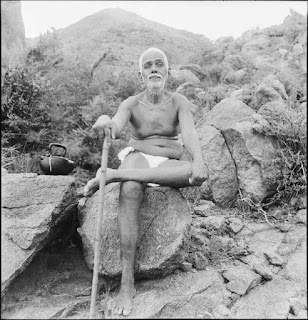Upadesa Saara - 2
Sri Ramana Maharishi
discusses Karma and Karma-Yoga in the first three verses of
Upadesa Saara. In the first verse he
refutes the philosophy of Purva Mimamsakas.
They believe that:
1. World and Vedas are eternal and not
created by God, as they don’t believe in
God but accept the Vedas
2. They believe that Karma by itself gives Karmaphala
as they don’t believe in a Karmaphala
dhata
3. Vedic rituals by itself gives all
benefits during and after life as well as get Moksha
They
do not attach any importance to the Jnana
Kanda portion of the Vedas. They are
referred to as Karmakandis and the Rishis of Taruka Vana were Karmakandis. So
in the opening verse Maharishi states that Karmaphaladhata must be a sentient
entity, as not mere Karma but motives
are also to be taken into account in determining Karmaphala
and Karma being non-sentient cannot
fulfil this role. He further makes a positive assertion for the existence of God
by emphasising that it is as only as per His dictates one’s Karmaphala is determined. The first verse:
कर्तुराज्ञया प्राप्यते फलं | (Karthurajnayaa prapyathe
phalam)
कर्म किं परं कर्म तज्जडम || (Karma Kim Param Karma Tad jadam)
कर्म किं परं कर्म तज्जडम || (Karma Kim Param Karma Tad jadam)
The fruits of all actions are
attained and controlled by God (Creator). Then how Karma can be superior? Karma
is just an insentient entity only.
From the first line it can
be inferred that there is a Higher entity, God, which is the srishti stithi laya karanam of this
world and God, who is Sarvajna, only
determines through His sankalpa the Karmaphala for different types of Karma i.e. whether papa or punya, when
to take effect and in what measure?, taking into account not only the action
but also the motive. Karma being insentient cannot play this
role and so it cannot be the ultimate authority. It is only subordinate to the Supreme, God,
whom we can refer to as Iswara.
In the second verse
Maharishi refutes the Karmakandis’ philosophy
that Karma itself can grant all purusharthas,
including Moksha. Maharishi points out that
mere Karma becomes the cause for
bondage and even a barrier in the spiritual path as it arises out of
desire. The second verse:
कृति महोदधौ पतनकाराणम | (Krithi mahodhadhau pathana kaaranam)
फलमशाश्वतं गतिनिरोधकम || (Phalam asasvatham gathi nirodhakam}
The big ocean of action is the cause of fall
down. The fruits of actions are not permanent and they obstruct the progress of
a spiritual seeker.
Every action of a human
being is prompted by a desire and there is no end to desire. It keeps
multiplying trapping one in it making Karma
a big ocean of Samsara. Each desire is responsible for a number of Karmas which in turn promotes more
desires. This vicious circle of Karma and
desire, i.e. Karma Kama cycle, is a
cause for stress and anxiety which can lead to one’s spiritual downfall. Further one cannot get the eternal purushartha of Moksha through rituals alone and all other fruits of Karma including Swarga are only transient and impermanent. This Sri Krishna points
out in Gita (9-21) where he states “After having enjoyed that vast heavenly
world (Swarga), they return to the
human world on the exhaustion of their punyaphala.
Thus, those who follow the rituals and duties prescribed in the three Vedas and
desirous of pleasures, attain the state of
going and returning (between earth and Swarga)".
Though Karma has these
limitations one cannot refrain from doing Karma. As Sri Krishna points out in Gita
(3-5):” No one ever remains even for a moment without doing work. For all are
made to work under compulsion by the Gunas
born of Prakrithi.”Maharishi in the next verse gives the
prescription for taking the sting out of Karma
and making it a vehicle for attaining Moksha. This verse gives the essence of Karma Yoga. The third verse:
ईश्वरार्पितं नेच्छया कृतम | (Ishwara arpitam na icchayaa kritam)
चित्तशोधकम मुक्तिसाधकम || (Chitta
shodhakam mukti sadhakam)
Work which is performed as
an offering to the Almighty and done without any expectation for the fruits, helps in purification of mind & thereby leads one to Liberation or
realisation.
Maharishi says “ Do perform
action, only change the motive. Let it be performed with a worshipful attitude
dedicating it to God”. Sri Krishna also
says the same in Gita (3-9):” This
world becomes bound by any action other than that action meant as worship (Yajna).
So without being attached, O Arjuna, you perform actions for Him.” This process can be described as doing work as
Yoga.
Since work is dedicated to God
one should accept with equanimity whatever result comes, be it favourable or
not as the result depends not only on one’s efforts but also on God’s Grace and
prarabdha. Sri Krishna also emphasises this point when
He declares in Gita(2-47) “Your right is for action alone, never for the
results’. In Kathopanishad work is classified as Preyas and Sreyas. Preyas is work for sense-pleasures linked with the body-mind
complex and Sreyas, work for spiritual
growth. While Preyas binds, bringing
pain and sorrow in its wake, Sreyas
liberates bringing eternal joy. But even
Preyas when done with Iswra Arpana Buddhi,
with no attachment to results can lead to purification of mind without causing
sorrow or pain.
This attitude of ‘Iswararpitham’ (dedication to Iswara) and ‘Nechchaya kritham’ (not
prompted by desire) will help us in neutralising our likes and dislikes
converting them to preferences from needs. This leads to ‘Chitta sodakam”(purification of mind) which becomes ‘Mukthi sadhakam’ (aid to Liberation).
--------------------------------

No comments:
Post a Comment